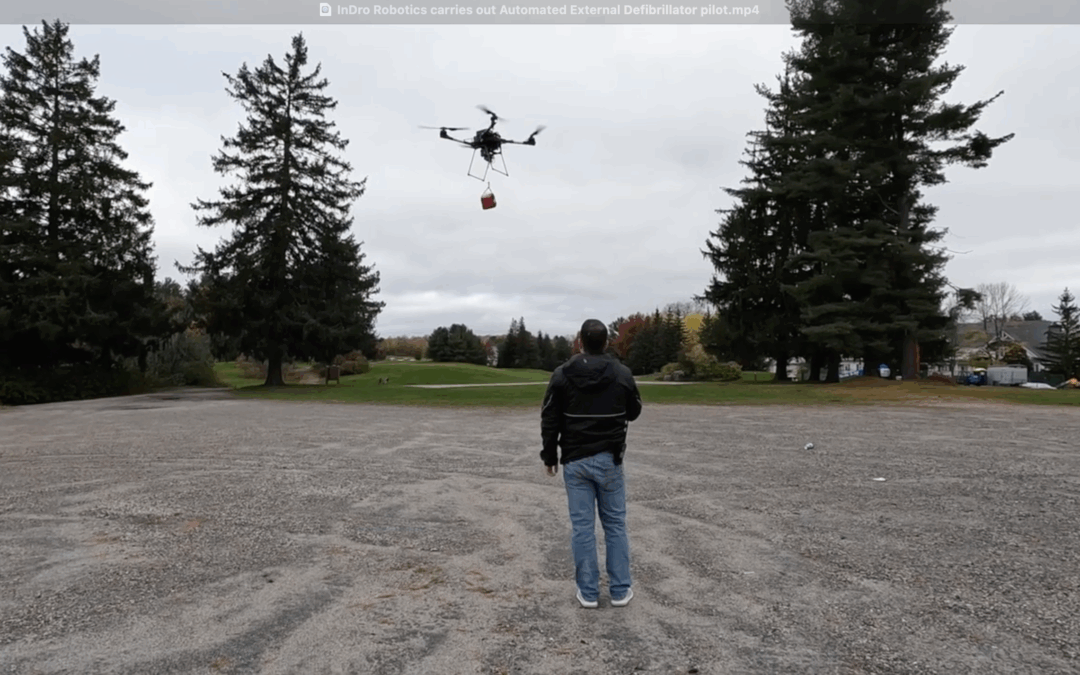By Scott Simmie
When someone goes into cardiac arrest, literally every second counts.
The chances of survival drop by between seven and 10 per cent for each minute that passes between the event and resuscitation. So getting an Automated External Defibrillator to the scene as quickly as possible can, literally, mean the difference between life and death.
Back in 2018, InDro partnered with the County of Renfrew Paramedic Service and Dr. Sheldon Cheskes, Affiliate scientist, Evaluative Clinical Sciences, in the Schulich Heart Research Program at Sunnybrook Health Sciences Centre, to carry out field research that compares the speed of delivering an AED via drone versus ground-based EMS. We have also worked with Peel Regional Paramedic Services on these trials.
Research was well underway, with multiple successful trials, when the pandemic hit and the project was paused. It has now resumed, and was recently featured in this news article.
Below: A video showing one of our test trials, where we lowered an AED kit at a precise location via winch
THE BENEFITS
The benefits are clear: The faster you can get an AED to a cardiac arrest victim, the more likely they are to survive. In multiple trials we worked with the County of Renfrew Paramedic Service to compare the speed of drone delivery with that of ground-based EMS. A simulated emergency call was placed, and the paramedics hit the road at speed. At the same time, we dispatched a drone carrying an AED.
The drone was faster – as it can head directly to the scene as the crow flies. This is particularly important in rural and remote settings, where roads only rarely present a direct route to the target destination.
In fact, Dr, Sheldon Cheskes and colleagues have been carrying out research to determine the feasibility of AED delivery by drone and have published papers in peer-reviewed journals.
In a 2020 research paper published in the Journal of the American Heart Association, they wrote about the results of six simulations in two rural areas. In one of those tests, the distance ground EMS had to travel was 20 kilometres, versus nine kilometres for the drone.
“During each flight, the AED drone arrived on scene before the ambulance, between 1.8 and 8.0 minutes faster,” they wrote. “This study suggests AED drone delivery is feasible, with the potential for improvements in response time during simulated sudden cardiac arrest scenarios.”
THE CHALLENGES
Getting the drone to the precise location is no problem. In fact, a 911 call contains the coordinates where the drone must be dispatched to – and that data can be automatically integrated into our flight planning software.
But because speed is of the essence, the research is also exploring how to most quickly get the AED from the drone into the hands of those awaiting the device on the ground. Is it faster to land the drone? Drop the device in a well-padded enclosure from a low height? Land and disarm the drone?
Then there’s the issue of instructing the Good Samaritans on the ground on how to effectively use the AED. In one of our trials, a cellphone was included with the AED. That cellphone was preset to a live video call with a First Responder. The moment someone opened the package, there was a professional on the other end who could offer instructions.
Below: Television coverage of when InDro first began exploring drone delivery of AED – all the way back in 2014
INDRO’S TAKE
As you just saw, we actually explored this use-case on Salt Spring Island long before the pilot project, with some tests back in 2014. So we could see the benefits of this use-case early on. Drone technology has improved immensely since then – meaning we can fly greater distances at greater speeds.
“We are immensely pleased to see this research get back underway after the pause forced by the pandemic,” says InDro Founder and CEO Philip Reece. “We’re also in a position now where we can explore using fixed-wing VTOL for greater speed and integrate more robust command and control protocols. Our ultimate, long-term vision includes the potential for a series of strategically placed docks in rural areas that contain drones and AEDs that can be automatically and autonomously dispatched the moment that 911 call comes in.”
We look forward to updating you after the next trial.

